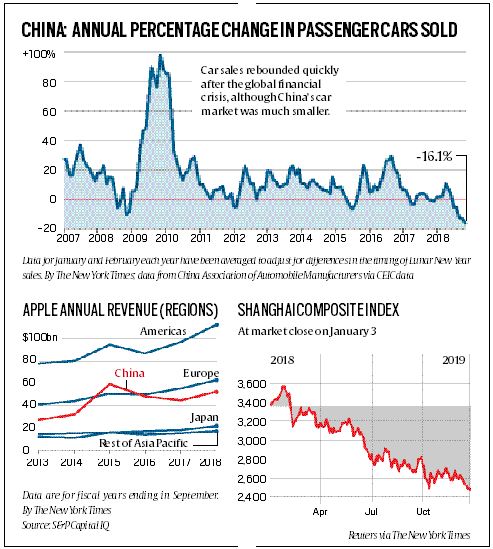Apple Thursday (Wednesday in the United States) cut its revenue expectations for the first quarter of 2019 (the financial year in the US runs from January through December) to $84 billion from the earlier estimate of between $89 billion and $93 billion. In a letter to investors, Apple Chief Executive Tim Cook blamed, among other factors, the decline in sales in China — “we did not foresee the magnitude of the economic deceleration, particularly in Greater China”, he said. “Lower than anticipated iPhone revenue, primarily in Greater China, accounts for all of our revenue shortfall to our guidance and for much more than our entire year-over-year revenue decline,” Cook said.

Missing revenue targets is a 16-year first for the world’s most valuable company and brand. The announcement by Cook is hard evidence of the sputtering of China’s economy, which has for long been a turbocharged superachiever by any standard.
“Apple is a bellwether,” a report in The New York Times Thursday quoted Mark Zandi, Chief Economist at Moody’s Analytics, as saying. “The iPhone is something that everyone knows and buys, and if people aren’t buying it, then that’s a pretty good sign they’re having a hard time.”
Story continues below this ad
Apple has been extremely successful in China — the country has more than 40 Apple stores, and is Apple’s third-largest market worldwide. The company’s sales in China touched almost $52 billion in the most recent fiscal year, the bulk of which were iPhones, The NYT report said.
However, after the Chinese economy began to slow in the second half of 2018 with, as Cook said, “government-reported GDP growth during the September quarter [being] the second lowest in the last 25 years”, the “climate of mounting uncertainty” sharply impacted consumer traffic to Apple’s retail stores and channel partners in China.

The slowdown has been indicated also in the relative emptiness of most high-end restaurants and the crashing of room tariffs at five-star hotels in Beijing and Shanghai, the huge glut and plunging prices in the country’s real estate market, and the record declines in automobile sales (from a year earlier) in the closing months of last year. Western economists are sceptical of statistics China puts out, but automobile sales data are considered reliable because of the heavy involvement of multinational giants like GM, Ford and VW. (see figure above)
The slowdown is widely expected to intensify in 2019, given the Trump administration’s trade war against Beijing, and with supply lines to the US already packed with surplus inventory. With very few new orders and weak exports, many purchasing managers believe the worst is still to come.
India: the opportunity
Story continues below this ad
With Cook blaming weak China demand as the primary reason for the fall in growth, followed by supply constraints of new products and slowing iPhone demand in many markets, some analysts believe Apple could possibly begin to put more emphasis on India for its future growth.
“With its challenges in China and other markets, India becomes more important for Apple,” said Navkendar Singh, associate research director, devices and ecosystem: India & South Asia, at the IT and telecom market intelligence and advisory services company IDC. “But to find success in India would call for a recipe that is different from other markets due to this market’s immense value-conscious nature and huge diversity.”
Apple has been trying to bring down the affordability barrier for its devices in India by offering finance solutions for most of its products. Still, Singh said, Apple’s market share in India’s smartphone market was only 1.2% between January and September, 2018, and even this was driven by the popularity of older models like the iPhone SE, which can be bought for Rs 16,999. By contrast, the iPhone XR, the cheapest of the new iPhones, costs Rs 76,900.
Singh guesses if Apple does indeed get more aggressive in India, it may not necessarily opt to push volumes or discounts; it may rather choose the value game — with structured distribution and price discipline. “They are not looking at volumes, but they are definitely bullish on the value that this market can deliver in the long term of five to 10 years,” he said.
Story continues below this ad
Interestingly, Quartz reported in November that while Xiaomi, the largest smartphone manufacturer in India, sold “over 10 times more smartphones” than Apple in the last fiscal, the latter’s profits were Rs 896 crore, three times that of the Beijing-based firm’s Rs 293 crore. Apple’s revenue stood at Rs 13,098 crore, almost half of Xiaomi’s Rs 23,000 crore, the report said, quoting regulatory filings. The value strategy then, may already be working for Apple.
Prabhu Ram, Head-Industry Intelligence Group at CyberMedia Research (CMR), however, said: “It remains to be seen how seriously Apple invests itself in India. Even now, Apple is looking at using India as an export hub only, and not as an attractive market.” Indeed, in November, Cook had said that Apple faces challenges in India.
And yet, India, unlike the US or China, remains a market in which smartphone sales continue to rise. Even if 80% of this market is for phones below $200, Apple’s aspirational brand remains strong among richer consumers. Also, with each upgrade, Indians are moving up the value chain and spending more on their next phone. And for those looking for a really premium smartphone, Apple is pretty much the only option now.
Supported by partners Foxconn and Winstrom, Apple is expected to widen its manufacturing base in India to a larger portfolio of products. The decision to move more assembly from China to India is seen as an attempt to keep the cost of the iPhone down amid increasing trade tensions between the US and China. The expansion of the existing iPhone manufacturing plants will reportedly create 25,000 jobs in the country.
Competition from China firms
Story continues below this ad
The competition in the smartphone market has increased over the past few months. Chinese firms Huawei, OnePlus, Oppo, Vivo, and Xiaomi have upped investments in India. Most of them are assembling smartphones locally, and some even have set up research and development centres. All of them play in the premium segment too, where Apple gets its numbers. If China slides, these companies, too, will look at India more seriously.
The iPhone has built Apple’s legend — and while it still accounts for the vast majority of its revenue, the company has begun to focus on increasing its service business, which includes the App Store and Apple Music, in its search for new growth avenues.

 (Image source: Bloomberg)
(Image source: Bloomberg)






































